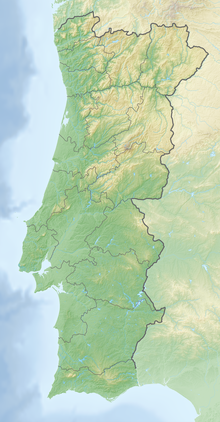Cartuxa Santa María de Scala Coeli
The location of the Charterhouse in Portugal. |
The Cartuxa Santa María de Scala Coeli (including Convento da Cartuxa ) is a former monastery of the Carthusian in Evora , in the region of Alentejo in Portugal . It is located in the Bacelo district , about one kilometer northwest of the old town of Évora, right next to the “ Aqueduto de Água de Prata ” aqueduct .
history
The Charterhouse was founded in 1587 on the initiative of Teotónio de Bragança , Archbishop of Évora from 1578 to 1602, in Évora. Thereupon seven monks first settled in the former royal palace, the Paço dos Condes de Basto , in the same year . Construction of the monastery began in 1593. After completion, the buildings could be inhabited from 1598. The monastery church and the large cloister were built between 1615 and 1621. The cloister is still the largest cloister in Portugal with its sides of 98 meters and an enclosed area of one hectare .
During the War of Restoration , Évora was captured by Spanish troops under the command of Juan José de Austria in 1663 . The monastery was looted and badly damaged. It was not until 1694 that the buildings could be restored with the support of the Portuguese King Peter II .
In 1834 the monastery was closed after a decree by Queen Maria II dissolved all orders in Portugal and the property of the monasteries and convents became state property. The monastery complex was sold. The proceeds were used to finance a hospital in Évora. The library and many works of art were lost. Parts of it are now in the National Archives of Torre do Tombo . In the following years the buildings served as an agricultural school and the monastery church was used as a barn.
At the end of the 19th century, Jose Maria Eugénio de Almeida , from the family of the Counts of Vilalva, bought the ruins. The church was declared a national monument in 1910. In 1955, Vasco Maria Eugénio de Almeida , the heir of the buyer, offered the order to re-establish a community of Carthusians in the monastery. The buildings were inhabited by Carthusian monks again from 1960, but the real estate remained in private hands. When Almeida died in 1975 without a direct heir, his property was transferred to the " Fundação Eugénio de Almeida " foundation , to which the monastery and its lands still belong today.
By decision of the General Chapter of the Carthusian Order, the monastery was closed in 2011 due to a lack of appointments. The Charterhouse was the only Carthusian monastery in Portugal.
Todays use
Today the " Eugénio de Almeida " foundation uses the former monastery complex under the name Convento da Cartuxa as a cultural and event center and runs a wine-growing business on the complex. The site is open to the public.
Web links
- Mosteiro da Cartuxa (Portuguese), accessed April 21, 2018
Individual evidence
- ↑ a b c d Analecta Cartusiana , accessed April 21, 2018
- ↑ a b c Website of the Carthusian Order , Portuguese
Coordinates: 38 ° 34 '52.4 " N , 7 ° 55' 11.2" W.

